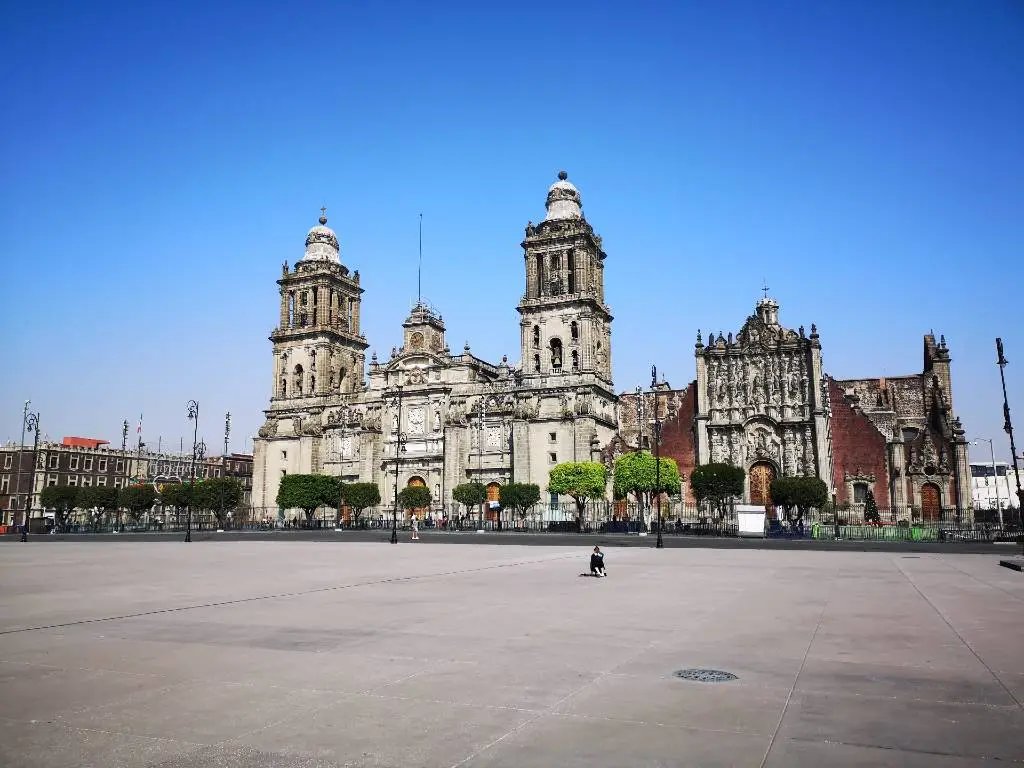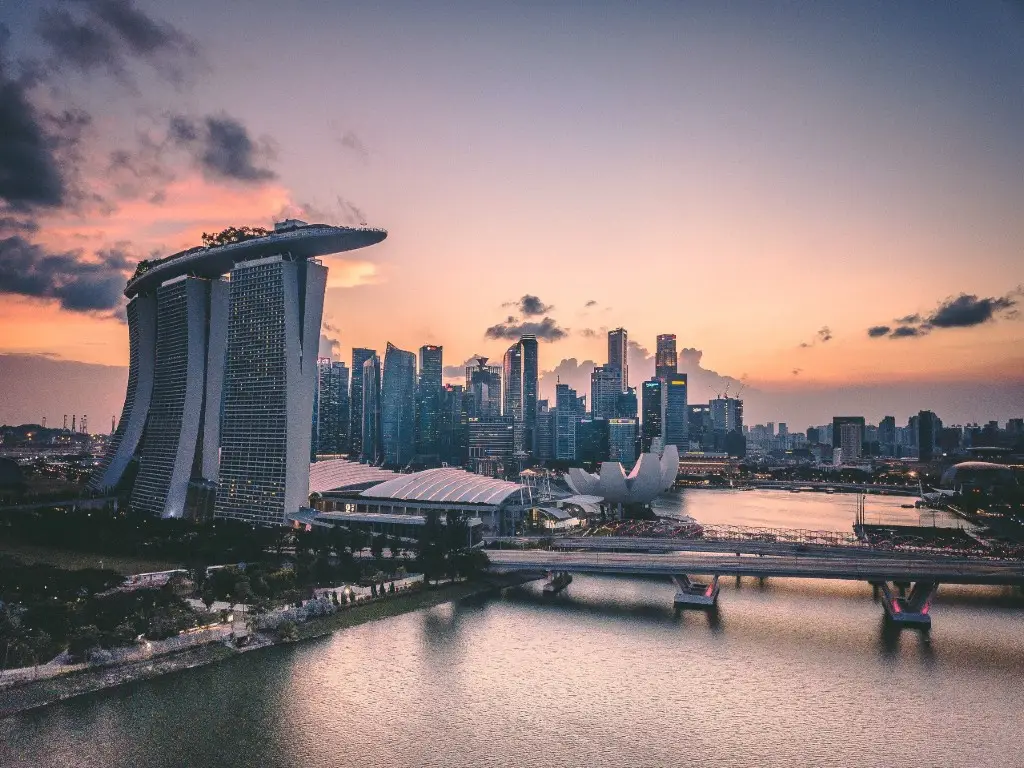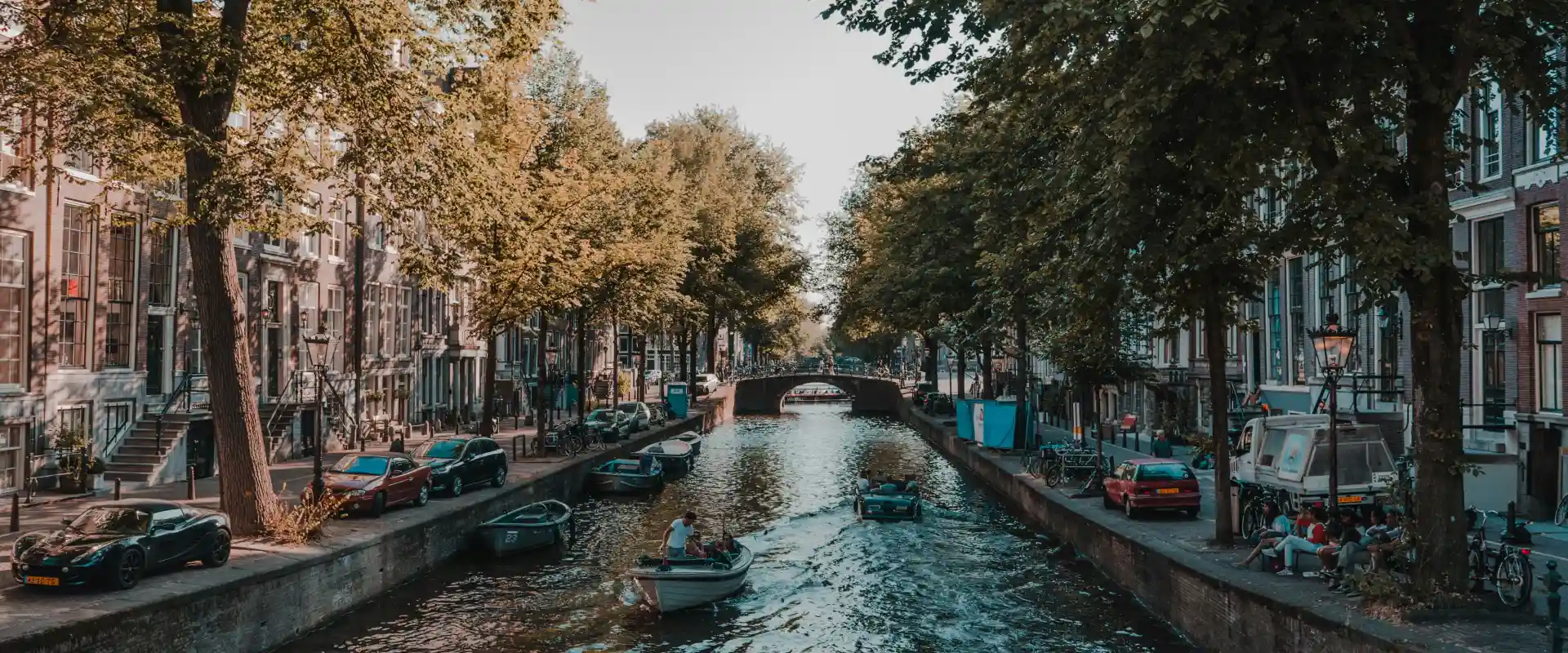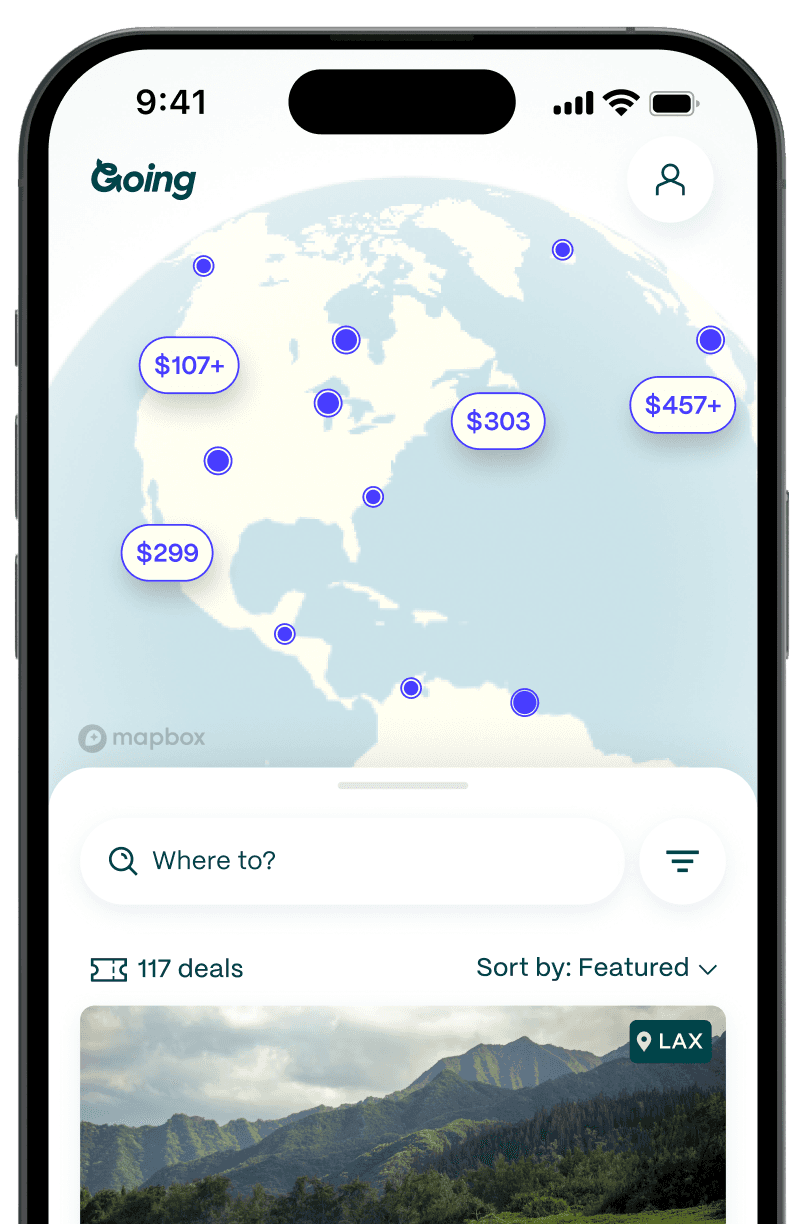
Layover in Panama City: What to Explore During Your Stop
Table of Contents
Key takeaways
- Panama City blends history and modernity, featuring the historic Casco Viejo with colonial architecture and the downtown skyline, alongside the world-famous Panama Canal and lush rainforests.
- Minimum connection times at the Panama City airport (PTY) vary—90 minutes for international connections, 4 hours if connecting between airports (Tocumen to Albrook), and 6 hours if you plan to explore the city.
- Taxis, Uber, buses, and the metro are common ways to get around in Panama City. The airport is well-connected to downtown, with travel times around 30 minutes depending on traffic.
- On your Panama City layover, explore Casco Viejo, visit the Panama Canal, enjoy tropical forests, or take a short trip to nearby beaches or Isla Taboga, with a vibrant nightlife scene in the historic district.
- With Going membership plans, you can get real-time alerts as soon as prices drop for domestic and international flights, even ones that route through Panama City. That way, you know you're getting the some of the cheapest flights every time.
Nicknamed the “Miami of the South,” Panama City is two cities in one. There’s the historic district of Casco Viejo with its narrow cobblestone streets, dreamy balconies and Spanish colonial architecture, and downtown Panama with its glittering skyline—Panama City ranks third for number of skyscrapers in the Americas after New York and Chicago.
It’s home to the world’s greatest feat of engineering, the Panama Canal, 17th-century ruins, rescued pirate treasure, tropical rainforests, and swinging nightlife. It’s also a gateway to beautiful beaches along both Panama’s Caribbean and Pacific coasts. Panama City is a common layover spot between the US and South America, and it can easily be enjoyed on a long layover between flights.

- VISA REQUIRED: NO
- MINIMUM CONNECTION TIME, INTERNATIONAL TO DOMESTIC: 90 mins
- MINIMUM CONNECTION TIME, INTERNATIONAL TO INTERNATIONAL: 90 mins
- MINIMUM CONNECTION TIME TO LEAVE THE AIRPORT: 6 hrs
Visa info for Panama
Americans do not need a visa to visit Panama.
Minimum layover times for Panama City
To make an international to domestic connection: 90 mins–4 hours
All international flights from the US arrive and depart from Tocumen Airport (PTY) but domestic flights may arrive and depart from either Tocumen or Albrook Marcos A. Gelabert Airport (PAC).
If your domestic flight departs from Tocumen Airport (PTY) where you arrived from the US, you should give yourself at least one hour (1.5 hours during peak periods and holidays). Transit passengers who aren’t leaving the airport do not have to go through immigration or customs.
If your domestic flight departs from Albrook Marcos A. Gelabert Airport (PAC), you’ll need more time, as PAC is about 18 miles from Tocumen (PTY). You’ll need a minimum of four hours to have sufficient time to clear immigration and customs and pick up any baggage and then cross Panama City by car, which can take anywhere between 45 minutes (with no traffic) and 90 minutes when traffic is bad (a taxi or Uber will cost $15-$25). You’ll then also need time to check in and go through security at the domestic airport.
To make an international to international connection: 90 mins–4 hours
The minimum layover time to make an international to international connection also depends on your airports. If you’re departing from Tocumen Airport (PTY), 90 minutes is a safe window (though you can often do it in much less time) as you do not need to leave the secure area between flights.
However, any travelers who are going to transit onto international flights with Air Panama or Wingo will depart from Albrook Marcos A. Gelabert Airport (PAC) or Panamá Pacífico International Airport (BLB), a small airport that only serves Wingo flights.
Getting to Panamá Pacífico Airport (BLB) from Tocumen (PTY) by taxi can take 60-90 minutes at a cost of $25-35. Give yourself a safe window of four hours for international connections from Panamá Pacífico International Airport (and from Albrook Marcos A. Gelabert Airport as mentioned above). It’s a very small airport so clearing security doesn’t take long, however, traffic may be heavy getting there as the journey requires crossing the Bridge of the Americas which sees a lot of traffic.
To leave the airport and explore for part of the day: 6+ hours
Travel from the airport into the city center takes about 30 minutes (depending on traffic), and you’ll want to get back to the airport at least two hours before your next flight, too. That means the minimum layover time to leave the airport and explore for part of the day is six hours, which leaves you about two hours for exploring. A layover in PTY of at least eight hours allows more flexibility and time to explore.
- 30-45 mins to deplane and go through immigration and customs
- 30 mins to transit to downtown
- 2 hours to explore
- 30 mins to return to airport
- 2 hours to go back through security, get to your gate, and board the plane
Getting from the Panama City airport to the city center
- BUS: 30 mins
- TAXI/UBER: 30 mins
There are three possible modes of public transport from Tocumen Airport (PTY) to the city center: the bus, official taxis and Uber.
The bus is the cheapest and longest option. It costs $1.25 and you will need a Metro Bus card, which you have to buy at the airport. Take the Tocumen-Corredor Sur bus (not Via España) and get off anywhere on Avenida Balboa to get a taxi within the city, or go all the way to Albrook station to get the metro or another bus. The journey into the city center takes around 30 minutes and it runs daily from 4am till 11:48pm. Note that you cannot board with large luggage; there is luggage storage at the airport for $5 per piece per day.
You can also take an official Panama City yellow taxi. They don’t operate by meter and it’s best to negotiate rates before you get in. An official taxi will usually charge $25-30 from the airport to the city center, though the price is typically higher at night or on Sundays. There is no need to tip unless you feel service is exceptional. If you’re connected to WiFi or have data, ordering an Uber is the painless way to get from the airport. Uber fares hover between $9-14 depending on the time of day and they’ll meet you at the parking bays right opposite arrivals.
There are also several car rental companies by the arrivals hall including Dollar, Sixt, Mex, Thrifty, Budget, and Hertz, should you wish to make your own way into the city. Parking is widely available though it pays to beware of “buen cuidados” who offer to help you park and then demand a fee. Driving within Panama City is fine but the roads outside the city (towards the interior and the San Blas Islands) are rugged and bumpy. Keep this in mind when selecting your vehicle.
How to spend a short layover at the Panama City airport
Tocumen Airport (PTY) has only one terminal; the second is under construction. Facilities include the usual duty-free stores, ATMs, currency exchange services, a food court, lounges (The Lounge Panama and a Copa Club lounge for Star Alliance members) and international stores such as Tommy Hilfiger, Adidas, Diesel, and Kate Spade. There are a few 24-hour cafes for quick bites.
The airport is known for being air-conditioned and often extra cold, so make sure you have layers to shield you from the arctic blast. You can get 30 minutes of free WiFi (per device) by joining the Eurona network or the Airport_Tocumen. WiFi also available for purchase.
How to spend a short Panama City layover outside the airport

If you’re exploring the city in daylight, head directly to Casco Viejo, the dining and entertainment hotspot. It’s the second-most visited place in Panama after the canal and the area is a pleasure to discover on foot. Everything is conveniently located within walking distance: hotels, chic eateries, ice cream parlors, quaint cafes, churches, historical squares and shops. While here, get the quintessential souvenir, a Panama hat, from Victor’s Panama Hats or buy souvenirs and trinkets from indigenous Kuna women at the outdoor stalls in Plaza de la Independencia or along Paseo Estaban Huertas, a seafront walkway with a bougainvillea canopy that offers great views of the Bridge of the Americas.
From Casco Viejo you can take a stroll to Cinta Costera, a scenic walkway and park that goes along the Bay of Panama. On this palm tree-lined promenade, you'll find picnics, joggers, an open-air gym, the iconic kaleidoscopic Panama sign, and tons of fresh air. Cinta Costera stretches from Casco Viejo to Punta Paitilla and essentially links the old town with the new.
For nature lovers, Panama City is blessed with two tropical forests where you’ll spot monkeys, sloths, keel-billed toucans, and agoutis (called ñeques here) if luck is on your side. Take a taxi to Cerro Ancon or Parque Natural Metropolitano for sweeping panoramic views after a brisk hike of around 40 minutes each. From the top of Cerro Ancon (Ancon Hill), you can see Panama City's impressive juxtaposition of new and old with Casco Viejo on your right, and the skyscrapers of “new Panama” on your left.
A layover in Panama City can easily be combined with a beach trip. Though Panama’s capital is a waterfront city, it’s along a bay, and there are no beaches within the city. However, there’s one 20 minutes away by taxi in Veracruz, where you’ll find numerous beachside bars—check out Praia, Veri Veri and Panorama—selling fresh seafood.
Isla Taboga, the “Island of the Flowers,” is also just 30 minutes away from the city by ferry. The Taboga Express ferry departs from Panama between 8am and 4:30pm. The first ferry back from Taboga is at 8:45am and the last is at 4pm. Return tickets cost $20.
Seeing the Panama Canal on a layover

The Panama Canal is the city’s star attraction and it’s definitely worth it, particularly if you get to see ships passing through—or better yet, a cruise. You can visit the canal by heading to the Miraflores Visitor Center, where there are terraces and observation decks with varied views as well as a 3D IMAX theater and an interactive, multi-story museum. A visit to the museum takes about an hour and provides insight into how this marvelous feat of engineering tore the country apart to unite two oceans, making it a must-see on a Panama City layover tour.
Ships pass through twice a day. To guarantee a sighting, it’s best to visit closer to 8am or in the afternoon after 2pm. The Miraflores Visitor Center is open daily from 8am-6pm. Entrance tickets are sold until 5:15pm at a cost of $20 for adults and $12 for children.
The easiest and fastest way to get to the Panamal Canal Miraflores Visitor Center from the Panama City Tocumen airport is by taxi or Uber. You do not need to join a tour to see the Panama Canal.
How to spend an overnight layover in Panama City
Panama City’s nightlife keeps going till around 3am. The lion’s share of glittering bars and clubs are in Casco Viejo, which is also known for its multitude of rooftop bars, such as Tantalo, Salvaje, Casa Casco and Lazotea. You can also dine till late at several of these establishments, making it a great option during a long layover in Panama City.
Outside of Casco Viejo, you can pay a visit to Panaviera, Central America’s highest pool bar, which is on the 66th floor of the Ocean Sun Casino in the ritzy Punta Pacifica neighborhood. The casino is open 24 hours but Panaviera closes at 2am. If you’re still going after that, swing by El Apartamento y e El Sotano, which is open till 4am every day except Monday when it’s closed (as many Panamanian businesses are).
Book a hotel in Casco Viejo, as this is the one area you don’t want to miss and it has the highest concentration of entertainment options within a small area. If you’re looking for a hotel near the airport, the Crowne Plaza Airport and the Riande Aeropuerto Hotel Casino are good options.
Need to Know

- CURRENCY: US Dollar
- LANGUAGE: Spanish
- SAFETY: A+
- COST: $$ (out of $$$$$)
- BEST TIME TO GO: Dec-Apr
Some of the best deals happen by accident! Discover mistake fares and save big on airfare.
Currency in Panama
Panama has two official currencies: the Balboa (PAB) and the US dollar, which has been accepted as legal tender for over a century. The Balboa exists only in coin form.
There is a Travelex currency exchange service inside the airport and you can also get cash from ATMs (there are several in the airport).
Cost in Panama City
Panama is more affordable than neighboring Costa Rica but more expensive than Colombia. Expect to pay $10-20 for a dorm room and $70-120 for a mid-range, 3-star hotel.
If you eat street food or at fondas (small, family-run diners with affordable meals), you can spend as little as $5 per meal. A mid-range dinner will hover around $15-20. A national beer is $3-5 and a cocktail or mixed drink costs $7-$10. Tax is added on top and it will appear on your bill as “ITBMS.” A bottle of water costs $1 but you can save money by refilling your own reusable water bottle; tap water is drinkable in Panama City.
Shopping at supermarkets may keep your food bill low though some items are particularly pricey, like avocados, cheese, and asparagus.
Don’t book another ticket without these flight hacks—get the best deals every time.
Weather & Best Time to Go to Panama City
Panama enjoys year-round warm weather and sunshine, with temperatures ranging between 75 and 88 degrees Fahrenheit, but there are two distinct seasons: dry and rainy.
The dry season (summer) runs from December to April, and is the most enjoyable time to visit. The rainy season is from May to November. The rainy season is more humid and you can expect roughly an hour of rain every day.
Over four days in February, Panama hosts the biggest carnival celebration in Central America. The whole country comes alive making this one of the best times to visit. In Panama City, the festivities are concentrated around Avenida Balboa where you can expect a procession of floats, dancers, traditional attire and revelers in wacky costumes.
November is a month of public holidays. Panama celebrates not one but two independence days, the first commemorating their separation from Colombia (November 3) and the second to mark their liberation from the Spanish in 1821 (November 28). The Los Santos Shout (Primer Grito de Independencia de la Villa de Los Santos) is sandwiched in there on November 10. Subsequently, many businesses are closed throughout November, and Panama City becomes somewhat of a ghost town as residents flock to the inland towns and the beaches.
Flights don’t have to break the bank! Discover smart strategies on how to find cheap flights and book at the lowest prices.
Safety in Panama City
Panama is ranked at 56 out of 163 countries in the 2020 Global Peace Index and it’s in the top three safest countries in Latin America. The president’s work quarters are situated in the tourist enclave of Casco Viejo, so there’s a strong security presence there, as well as dedicated tourist police. For added security, take Ubers at night rather than yellow taxis and, as with anywhere in the world, keep your wits about you.
Transport in Panama City
Panama has a robust network of clean, air-conditioned buses (Metro Bus) though some old “Diablo Rojo” jazzed-up school buses still serve some routes. You will need to purchase a Metro Bus pass before getting on a bus. You’ll need to scan it when you get on and each journey costs $0.25 Cents.
Panama City also has a metro system that runs 5am to 10pm most days (with reduced hours on Sundays). A single journey costs $0.35 Cents.
The best way to get around is undeniably by taxi. Uber is legal and rides are alarmingly affordable; a 20-minute journey costs on average $3 within the city. Yellow taxis may be cheaper depending on where you’re going and traffic levels. Bear in mind that drivers of yellow taxis have an aversion to seatbelts—you’ll notice they’ve been ripped out of many cabs.
Food & Drink in Panama City
Be sure to try sancocho, Panama’s national dish. It’s a broth of chicken, corn on the cob, starchy vegetables and culantro (not to be confused with cilantro), and it’s reputed to be one of the best hangover cures in the world. Panama’s version of the snow cone, raspao, is a delightful refresher that’s often topped with condensed milk.
Coffee lovers shouldn’t miss an opportunity to try Panamanian Geisha–one of the most expensive coffees in the world. Dubbed “the Champagne of coffees,” it incidentally tastes more like tea. Seafood lovers should visit the Mercado de Mariscos fish market for cheap and cheerful fresh ceviche and generous seafood portions. Typical Panamanian food can be enjoyed in Casco Viejo at Fonda Lo Que Hay or Diablicos restaurant.
Panama has a booming craft beer scene. One of the most prominent breweries is La Rana Dorada, which has a generous happy hour (half price beer all afternoon Monday to Saturday) and each new customer is gifted with a sample tray in the shape of a Panama Canal ship.
Language
Spanish is the official language in Panama, though a strong ex-pat community and years of US influence means English is widely spoken—particularly in the restaurants, bars and shops of Casco Viejo where many visitors spend most of their time. It does help to speak a bit of Spanish but you can get by without it.
Don’t miss
A hidden gem within the city is the Biomuseo (Bio Museum), a celebration of architecture and nature on the Amador Causeway, a stretch of land made with rocks and sand from the excavations of the Panama Canal. Frank Gehry designed the impressive, colorful structure and it’s his only work in Latin America. Visit the museum masterpiece to learn some mind-boggling facts about Panama and its ecological impact on the world.
Don’t bother
Many guides will tell you to go to Panama Viejo, the archeological site where Panama City was situated before pirate Henry Morgan sacked the city in 1671. While these well-preserved ruins are indeed impressive, it’s a fair journey from the airport and the city center. Skip Panama Viejo. Instead, spot ruins right within the historic old town of Casco Viejo, including the ruins of Iglesia de Santo Domingo, the Iglesia de Compania de Jesus ruins, and parts of the city’s old defensive walls scattered around the four plazas.
Read our guide to booking a flight with a long layover, see Going's deals on flights to Panama City, and join today to get cheap flights from all over the world delivered right to your inbox.
Frequently asked questions
Do you have to go through customs on a layover in Panama City?
Can I leave the airport during a layover in Panama?
Do I need a visa if I have a layover in Panama?
Is Panama City airport big?
Last updated February 28, 2025









